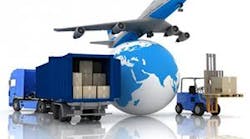Ecommerce continues to be the most rapidly growing third-party logistics (3PL) segment as retailers rely on Amazon and third-party logistics providers to help manage omnichannel and eCommerce operations.
As 2020 as e-commerce purchases continue during the pandemic and companies continue to outsource versus build internal fulfillment operations, U.S. 3PL e-commerce revenues reached $43.4 billion in 2019 and expect a 28% CAGR through 2020, according to a new report." VOLATILE – Latest Third-Party Logistics Market Results and Predictions for 2020 Including Estimates for 190 Countries” from Armstrong & Associates, Inc.
With COVID-19 stay-at-home orders and business shutdowns, Value-Added Warehousing and Distribution (VAWD) had significant growth in business-to-consumer (B2C) e-commerce fulfillment activity during the first half of 2020, while business-to-business (B2B) activity waned. The overall impact for the first half of 2020 was a VAWD gross revenue decline of 7.1% and a net revenue decrease of 5.8%. Q3 and Q4 should see incremental increases as the economy continues to comeback in spits and spurts, and as VAWD customers rush to restore inventory levels.
Within the asset-heavy Dedicated Contract Carriage (DCC) 3PL market segment, gross revenue was off 3% for the first half of 2020 and net revenue saw a slight decline year-over-year. DCC segment shipment volumes declined, but the overall impact was lessened due to the longer-term nature of its customer agreements.
The firm anticipates the COVID-19 economic volatility in domestic transportation and increases in domestic transportation demand to positivity impact DCC growth for the remainder of the year as shippers look for a safe haven for capacity and as DCC providers continue to benefit from contracts negotiated prior to the pandemic.
The Domestic Transportation Management (DTM) 3PL segment for H1 2020, saw an 8% drop in gross revenues and a 16% decline in net revenues as shipment volumes dropped off across all modes, especially with customers in Automotive, Industrial, Building/Construction, and Elements/Raw Materials vertical industries. Reefer and Dry Van Truckload fared better than construction dependent Flatbed.
The International Transportation Management (ITM) 3PL segment, consisting of air and ocean freight forwarding and complimentary value-added services saw 3.8% gross revenue growth in the first half of 2020. In Q2 2020, ocean and air volumes were off, while air and ocean capacity both remained tight. This resulted in significant rate increases over last year which drove up gross revenues. With the shutdown, commercial airline belly space, which accounts for approximately 40% of total capacity, went away and ocean carrier capacity tightened due to blank (canceled) sailings out of Asia.
In 2019, overall U.S. 3PL market net revenues (gross revenues less purchased transportation) grew 5.9% to $91.5 billion, while overall gross revenues declined 0.3%, bringing the total U.S. 3PL market to $212.8 billion.
For 2020, overall U.S. 3PL gross revenues are predicted to work back to a lesser year-over-year decline of just under 1% and a slight net revenue increase for the year.
Global third-party logistics revenues reached $951 billion in 2019 resulting in a mere 2.1% increase over 2018 versus the 9.1% increase it registered in 2018. Due to COVID-19 and trade war headwinds, we are expecting a 2.9% decrease in 3PL revenues globally.



